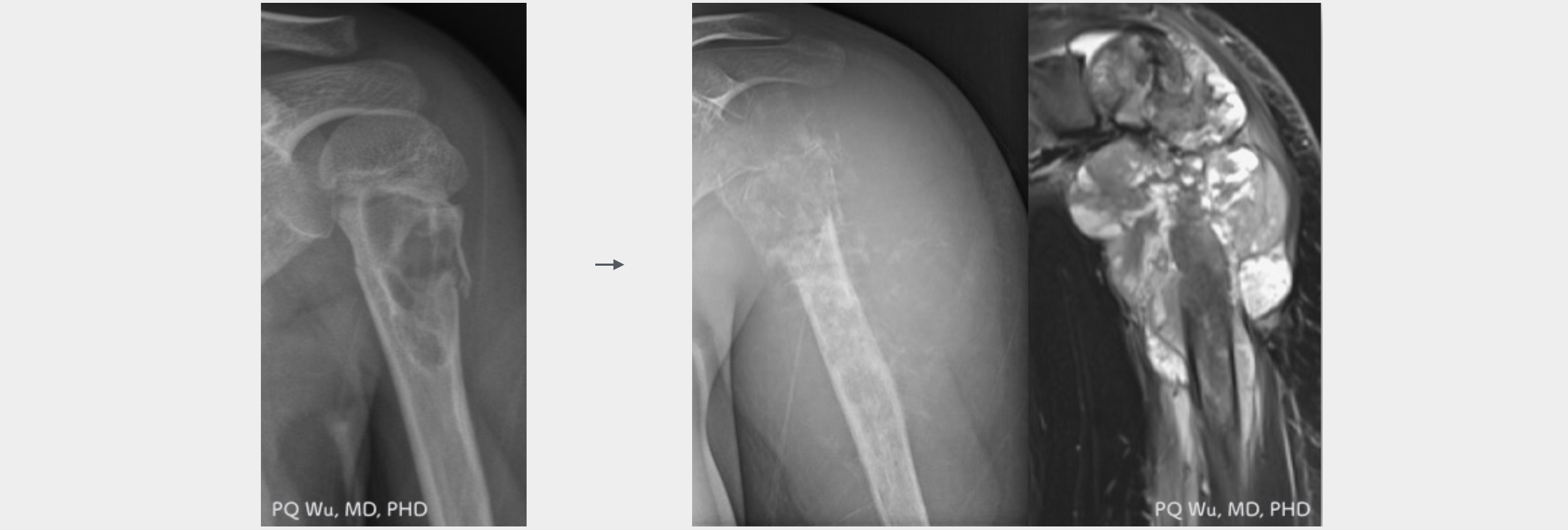Current studies point the source of the tumor cells in osteosarcoma to the transformation of self primitive mesenchymal stem cells. (Note 1). However, the complete pathogenic mechanism is still unclear but not related to genetic inherence. In other words, the formation of osteosarcoma has nothing to do with 'Mom and Dad', and parents must not blame themselves! Besides, patients with osteosarcoma will not influence their next generation! At present, the known causes of occurrence are divided into three categories as follows:
When sperm merge with the egg, it gradually develops into embryonic cells. Embryonic cells can develop into three layers, including the Ectoderm, Mesoderm, and Endoderm. The cells in the mesoderm are mesenchymal cells aligned loosely, which later develop into bone, cartilage tissue, muscle, adipose tissue, smooth muscle tissue, neural palate, and vascular endothelial tissue. When a genetic mutation occurs in a mesenchymal cell, it can easily lead to tumor formation.
There are genetic mutations associated with osteosarcoma, such as Retinoblastoma and Li-Fraumeni syndrome. The respective genes are the retinoblastoma (RB1) tumor suppressor gene and the TP53 tumor suppressor gene. Other less common cases, such as Rothmund-Thomson syndrome, Bloom syndrome, and Werner syndrome, also have a higher chance of developing Osteosarcoma (Note 2).
Some osteosarcomas transform from other bone tumors, such as Multiple myeloma, Enchondromatosis (Ollier's disease), Osteochochondromatosis, Paget's disease, and Fibrous dysplasia, etc. They will also turn into malignant osteosarcoma.

Patient 1: With aneurysmal bone cyst, turning into malignant angiosarcoma of bone seven years later.
Patient 2: With pelvic osteochondroma, turning into a malignant chondroma ten years later.
The most common contact factor is irradiation. Studies show that osteosarcoma or other malignant tumors may develop during or after five to 13 years after exposure to radioactive substances such as radiation therapies, nuclear explosions, etc. The Japanese Radiation Effects Research Foundation publishes the best-related studies in 2011 and 2013 in JBJS-A, a well-known orthopedic journal in the United States (Note 3). From more than 80,000 followed cases, the team found a total of 19 patients with malignant osteoma. Other reported exposure histories include chemicals such as BeO, or beryllium oxide (Note 4).
Note 1: Osteosarcoma originates from mesenchymal stem cells in consequence of aneuploidization and genomic loss of Cdkn2. J Pathol. 2009
Note 2: The Etiology of Osteosarcoma. In: Pediatric and Adolescent Osteosarcoma. Vol 152. Cancer Treatment and Research. Boston, MA: Springer US; 2009
Note 3: Exposure to ionizing radiation and development of bone sarcoma: new insights based on atomic bomb survivors of Hiroshima and Nagasaki. J Bone Joint Surg Am. 2011
Ionizing Radiation Exposure and the Development of Soft-Tissue Sarcomas in Atomic-Bomb Survivors. The Journal of Bone and Joint Surgery. 2013
Note 4: Osteosarcoma induced by beryllium oxide. The American Journal of Pathology. 1950
We highlighted the three common causes of osteosarcoma. Again, it is not an inherent genetic cause. In other words, the formation of osteosarcoma has nothing to do with 'Mom and Dad', and parents must not blame themselves! Besides, patients with osteosarcoma will not pass to their next generation!



